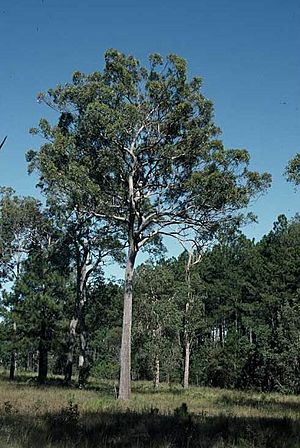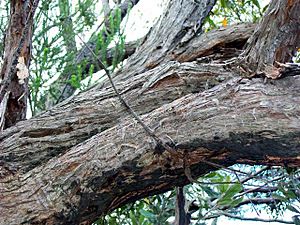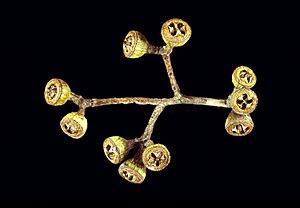Broad-leaved white mahogany facts for kids
Quick facts for kids Broad-leaved white mahogany |
|
|---|---|
 |
|
| Eucalyptus umbra near Gympie | |
| Scientific classification | |
| Genus: |
Eucalyptus
|
| Species: |
umbra
|
The broad-leaved white mahogany (scientific name: Eucalyptus umbra) is a type of small to medium-sized tree. It's special because it grows naturally only in a specific part of northern New South Wales, Australia. This tree has rough, stringy bark on its trunk and branches. It also has long, curved leaves, flower buds that grow in small groups, white flowers, and fruit shaped like a cup.
Contents
What Does the Broad-leaved White Mahogany Look Like?
The broad-leaved white mahogany usually grows up to 25 meters (about 82 feet) tall. It has a special woody swelling at its base called a lignotuber, which helps it regrow after fires.
Leaves
Young plants have leaves that are directly attached to the stem (this is called sessile). These leaves are broad and egg-shaped or spear-shaped. They can be quite large, from 80 to 200 millimeters (about 3 to 8 inches) long and 35 to 100 millimeters (about 1 to 4 inches) wide. They grow in pairs opposite each other and wrap around the stem.
As the tree gets older, its leaves change. Adult leaves grow one after another along the stem. They are green on both sides and are shaped like a spear or are slightly curved. They measure 60 to 180 millimeters (about 2 to 7 inches) long and 15 to 45 millimeters (about 0.6 to 1.8 inches) wide. Each leaf has a short stalk called a petiole, which is about 10 to 20 millimeters (0.4 to 0.8 inches) long.
Flowers and Fruit
The flower buds usually grow in clusters at the ends of the branches. Each cluster is on a stalk called a peduncle, which is 6 to 20 millimeters (0.2 to 0.8 inches) long. The individual buds are on smaller stalks called pedicels, about 3 to 7 millimeters (0.1 to 0.3 inches) long.
When the buds are ready to open, they are oval-shaped, about 6 millimeters (0.2 inches) long and 3 to 4 millimeters (0.1 to 0.2 inches) wide. They have a cap-like top called an operculum, which can be cone-shaped or have a small beak. The broad-leaved white mahogany blooms from September to February, and its flowers are white.
After the flowers, the tree produces woody fruits. These fruits are shaped like a cup or half a sphere. They are 3 to 7 millimeters (0.1 to 0.3 inches) long and 6 to 10 millimeters (0.2 to 0.4 inches) wide. Inside, they have valves (parts that open) that are usually near the rim or slightly below it.
How Did It Get Its Name?
The broad-leaved white mahogany was first officially described in 1901 by a botanist named Richard Thomas Baker. He published his description in a scientific journal called Proceedings of the Linnean Society of New South Wales.
The scientific name Eucalyptus umbra has a special meaning. The word umbra comes from Latin and means "shade" or "shadow." This name might have been chosen because the tree provides good shade.
Where Does This Tree Grow?
The broad-leaved white mahogany grows in areas of northern New South Wales, Australia, that get a lot of rain. You can find it between the cities of Sydney and Grafton. It prefers to grow in dry sclerophyll forests or woodlands, often in poor, shallow, and dry soils.
This tree is part of a group of similar trees known as the "white mahogany group." Other trees in this group include E. acmenoides, E. mediocris, E. carnea, E. apothalassica, E. helidonica, E. psammitica, and E. latisinensis. The broad-leaved white mahogany is different from the white mahogany found in coastal Queensland because its young leaves are wider.



